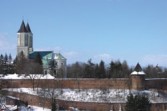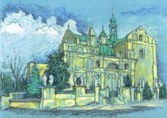If you have some time left, we suggest that you go down the stairs to Podzamcze Street, in order to appraise from below the qualities (mainly defensive ones) of the place where Jarosław was relocated in 1375. Going back, you can go up by another stairway and make for St Nicolas hill.
On your way make sure to stop by the Corpus Christi church.
It was founded in the last quarter of the 16th century by Zofia ze
Sprowy and placed under the invocation of St John the Baptist and St
John the Evangelist. It is presently the oldest post-Jesuit church in
Poland.
The architectural style is connected to the Roman Il Gesu church, on which most of the Jesuit temples in Europe were modelled. The church in Jarosław has a beautiful screen façade emphasized by the partly preserved attic and marvellous sculptures by Tomasz Hutter, one of the best sculptors of the 18th century. This façade forms a fine setting for the unique, compact square which was created when the Jesuit College buildings were constructed.
After the dissolution of the order and the dismantling of the parish church, the Jesuit church was once more consecrated, placed under the invocation of the Corpus Christi and became the parish church, while the buildings of the college were adapted as barracks. Most of the interior decorations of the church originate from the beginning of the 20th century; this is due to the conflagration of 1862. It is also worthwhile to turn your attention to the polychrome painting by Leonard Winterowski, the contemporary mosaic depicting John Paul II and the monumental bronze door with scenes from the history of Poland designed by Stanisław Lenar. A part of the former barracks was used in the inter-war period by the Polish Army, it now houses the Artistic School Complex.






















